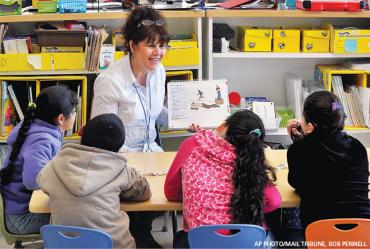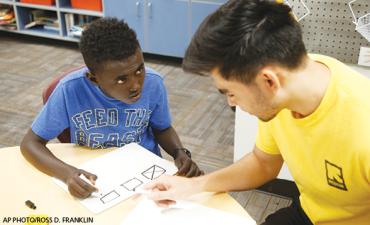Students with interrupted formal education, also known by the acronym SIFE, are a relatively small proportion of recently arrived English language learners (ELLs), probably somewhere between 10 and 20 percent.1 However, these students often represent the most challenging of our ELLs because of their limited first-language literacy skills, frequent gaps in academic knowledge and skills, and, sometimes, critical social and emotional needs. Also, many tend to arrive unaccompanied as teenagers, making their need to catch up academically even more urgent.
Educators and other professionals who have the responsibility and privilege of getting to know these students, and who will be helping them to reach their full potential, need to have an understanding of where these students have been and why they may have certain gaps in their academic knowledge. Such an understanding will build empathy for these students, and it can also help classroom teachers discover the most effective methodologies and materials that will bridge the gap between what SIFE already know and can do, and what they will be expected to be able to do in their new academic setting. Since most ELLs spend the majority of their school day in mainstream classrooms, we hope that all teachers will see the value in knowing more about the background of their students and how their previous educational experiences (or lack thereof) impact their ability to perform on a daily basis.
So, who are these students, and where are they coming from?
The highest percentage of SIFE in the United States comes from Latin America, mainly Mexico, Central America, and the Caribbean. Refugee children make up the second highest number, with students from Asia, Africa, and the Middle East. Other smaller groups are composed of immigrant children from countries where schools were poorly equipped, teachers were inadequately trained, or school was not accessible due to geography, economics, or religion.
Characteristics of SIFE
What specifically defines students with interrupted formal education and sets them apart from a “typical” English language learner? One list created by researchers2 states that these students:
- Are overage for their grade-level placement due to their weak academic skills and limited or inadequate formal schooling;
- Have needs that traditional ESL (English as a second language) and bilingual programs can’t or don’t meet;
- Have low or sometimes even no literacy skills in their first language and/or in English, and have little academic content-area knowledge;
- Are socially and psychologically isolated from mainstream students;
- Need approaches and materials that will help them catch up to and compete with mainstream students; and
- Are at risk of failing or dropping out of traditional academic programs.
The final bullet point, the higher dropout rate of SIFE, is especially disturbing. Richard Fry, of the Pew Research Center, estimates that about 70 percent of immigrants with interrupted schooling drop out of high school!3 Why are we seeing this huge number? One strong possibility is that the support these students are currently receiving is not adequate to meet their needs.
In addition to the dropout rate, there is another possibility that many of these young people never bother to enroll in school at all. While our book, Students with Interrupted Formal Education: Bridging Where They Are and What They Need, from which this article is excerpted, looks at what educators can do to provide assistance and support for the students who enter our classrooms, a larger societal issue is the number of students who choose work over school, as Fry notes:
The dropout rate for teens with school problems before migration is in excess of 70 percent, in comparison with 8 percent for other foreign-born youths. And their characteristics, especially for males, suggest that many of them are labor migrants. Their purpose in migrating was probably to seek employment in the labor market, and they may have never enrolled in U.S. schools. Recently arrived males who did not make adequate school progress before migration are twice as likely to be working as other foreign-born males, and nearly 40 percent of them are in the agriculture and construction industries, in comparison with 10 percent of other foreign-born youths. In contrast to the living arrangements of other foreign-born youths, the majority of recent arrivals with prior school problems do not reside with any parent in the household. Given their participation in the labor market and the degree to which they were behind in school, the prospects of enrolling these youths in traditional high school settings appear to be remote.4
Unfortunately, the programming designed for ELLs with academic skills and first-language literacy, as well as for the students who have been in Western schools for most if not all of their education, is not sufficient for most students with interrupted schooling. The gap between what students are expected to be able to do and the skill set that students have at their disposal is often too great, and students frequently give up.
Students with interrupted education need specialized programming and assistance, above and beyond what is normally provided to ELLs. This belief is supported in a recent statement from WIDA (a consortium of 40 states whose education departments have joined together to develop English proficiency standards and assessments)* about SIFE: “Students with this background often need their emotional, psychological, and physiological needs to be met before they are able to engage fully in the educational setting.”5 Once these needs are met, schools must help students build literacy skills† in their home language and English, fill in the gaps in content knowledge, and support their social and emotional needs.
The Council of Chief State School Officers6 created this list of supports it recommends for secondary school newcomers (including those with interrupted education):
- Build environments that respond to the immediate social, cultural, and linguistic needs of immigrant adolescents with limited schooling.
- Create structures that transcend high school academic departmental divisions to support simultaneous linguistic and academic development.
- Form newcomer centers to ease transitions for newly immigrated students.
- Implement flexible scheduling to reflect real needs and obligations of high school immigrants.
- Align high school programs with higher education and adult education.
- Use the full resources of the community to support immigrant students.
Identification of SIFE
One of the challenges of working with students with interrupted education is simply identification. Many school districts don’t keep track of how much education students have received in their home country and their level of first-language literacy. Even when schools do ask, the answers are not always as helpful as it is assumed they would be. First of all, parents may state that their children have six or eight years of schooling, but attendance may have been sporadic; they may have attended one-room schoolhouses with poorly trained teachers; or school may have only been for a few hours a day.
Sometimes, the parents do not want to admit that their child was not in school regularly out of fear that they may not be permitted to enroll. They may not want to admit that the child was not able to attend because of the inability to pay for required books or uniforms, or that the child stayed home regularly to provide needed income for the family. In some countries, children with learning issues are not able to be provided for in a regular school setting, and the child simply stays home. To guarantee that their child will be admitted to the new school, certain facts are not disclosed, or the parents may not realize how schooling is different in their new setting.
As some researchers have written, “Gaps in school attendance are often due to sensitive matters; parents/guardians may be embarrassed, distressed, or feel threatened if they sense in any way that they are being censured or blamed for the lack of complete [and accurate] school records or their children’s incomplete prior educational experiences.”7
However, it is important that schools collect as much data as possible about each student and share that information with the classroom teacher. As long as schools are unable to collect accurate knowledge of previous literacy and content instruction, matching students with the best instructional program will remain an elusive goal.
Brenda Custodio is an independent education consultant who prepares pre-service and in-service teachers at Ohio State University to work in second language classrooms, and is a former middle and high school English as a second language (ESL) teacher. Judith B. O’Loughlin is an independent education consultant, a former trainer of pre-service educators at New Jersey City University, and a former English, ESL, and special education teacher. This article is excerpted with permission from their book, Students with Interrupted Formal Education: Bridging Where They Are and What They Need. Copyright 2017, Corwin. All rights reserved.
*For more on WIDA, visit https://wida.wisc.edu. (return to article)
†For more on building ELLs’ literacy skills, see “Educating English Language Learners” in the Fall 2018 issue of American Educator, available at www.aft.org/ae/fall2018/august. (return to article)
Endnotes
1. Advocates for Children of New York, Students with Interrupted Formal Education: A Challenge for New York City Public Schools (New York: 2010); and J. Ruiz-de-Velasco and M. Fix, Overlooked and Underserved: Immigrant Students in U.S. Secondary Schools (Washington, DC: Urban Institute, 2000).
2. Y. Freeman and D. Freeman, Closing the Achievement Gap: How to Reach Limited-Formal-Schooling and Long-Term English Learners (Portsmouth, NH: Heinemann, 2002), 33.
3. R. Fry, The Higher Drop-Out Rate of Foreign-Born Teens: The Role of Schooling Abroad (Washington, DC: Pew Research Center, 2005).
4. Fry, The Higher Drop-Out Rate, 1.
5. WIDA Consortium, Focus on SLIFE: Students with Limited or Interrupted Formal Education (Madison, WI: 2015), 2.
6. Council of Chief State School Officers, Immigrant Students and Secondary School Reform: Compendium of Best Practices (Washington, DC: 2004), 11.
7. A. DeCapua, W. Smathers, and L. Tang, Meeting the Needs of Students with Limited or Interrupted Schooling (Ann Arbor, MI: University of Michigan, 2009), 10.




